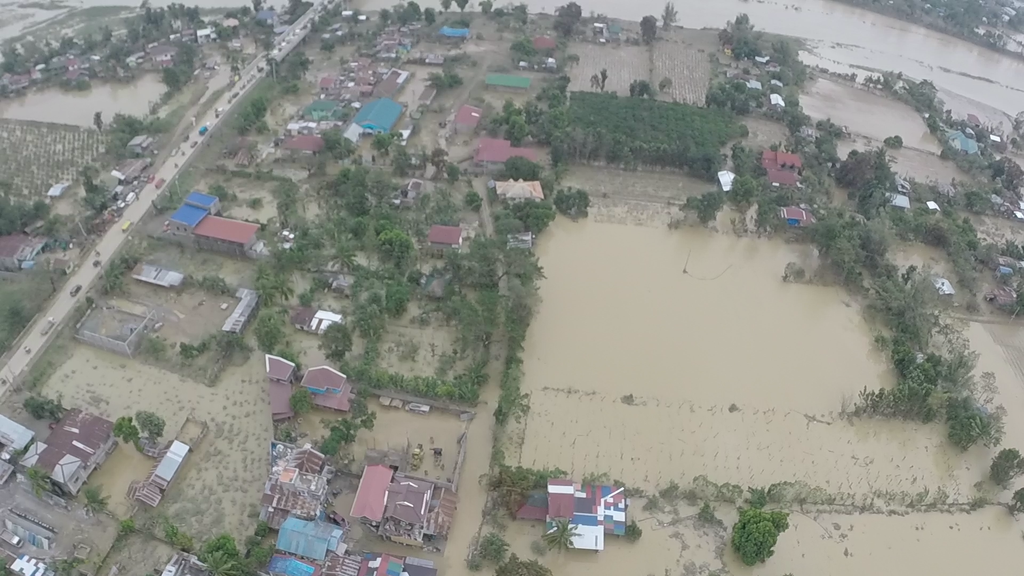
Rapidly responding to Typhoon Koppu
Typhoon displaces more than 1 million people
Category-3 Typhoon Koppu (known locally as Lando) made landfall over Casiguran municipality in Aurora province in Region III on 18 October. While not striking with the same strength as super Typhoon Haiyan (Yolanda) in November 2013, Typhoon Koppu was unusually large and slow-moving and brought intense rain within its 650 km diameter for more than four days. It caused flooding, flash floods and landslides, leaving 48 people dead, 83 injured and 4 still missing, according to the National Disaster Risk Reduction and Management Council (NDRRMC). The typhoon steadily weakened to a low pressure area as it exited the Philippine Area of Responsibility a week after landfall, affecting all seven regions of the Luzon island.
The number of evacuees reached a peak of 1 million people on 29 October, 11 days after typhoon’s landfall. Northern Luzon is a mountainous region and it took several days for the rainwater to flow downstream and exacerbate flooding in the low-lying river basins where floodwater is known to recede slowly. Flooding persists in the provinces of Pangasinan (Region I), Pampanga and Bulacan (Region III) in the Cagayan and Pampanga river basins as of 3 November while subsiding elsewhere. It could take until mid-November for the floodwaters to completely recede. Prolonged displacement due to persistent flooding raises the risk of water-borne and communicable disease outbreaks.
Some 713,600 people remain displaced as of 3 November. The vast majority are with relatives and friends or in the open nearby their damaged homes in Regions I, II and III where damage to houses was the most significant. People with damaged houses may remain displaced until their homes are repaired or reconstructed, requiring extended humanitarian aid such as enhanced disease surveillance, shelter repair kits, protection particularly against trafficking, and livelihoods support.Flooding devastates small-scale farmers already suffering from El Niño
Typhoon Koppu flooded vast tracts of agricultural land in Region III. Estimated cost of damage to agriculture reached US$180 million, primarily in crop loss, according to the Department of Agriculture. Rice, which is the staple crop in the Philippines, constitutes 88 per cent of the crop production loss.
Recovery of small-scale farmers will be slow as many do not have access to credit and their current cropping season (May to October) was already affected by the intensifying El Niño since early 2015, according to the government-led multi-sectoral rapid damage and needs assessment (RDANA) undertaken from 22 to 27 October. With now two consecutive cropping seasons ruined, the next harvest is expected a year from now, raising concerns for deterioration in food insecurity and malnutrition. A rapid provision of agricultural inputs will help restore and protect the availability of food as well as to rebuild the livelihoods of those hard-hit by the typhoon.Partners respond with in-country resources upon Government’s request
Government-led early warning, pre-emptive evacuations and various preparedness measures that were supported by communities, civil society organizations, the Philippine Red Cross, the private sector and other partners saved lives. The Response Pillar of the NDRRMC, one of the four disaster risk reduction and management pillars, established Task Force Casiguran to set up a humanitarian coordination hub in Casiguran on 23 October to support local authorities manage the humanitarian response for Aurora, where Typhoon Koppu made landfall. The task force was quickly stood down on 28 October when the situation stabilized.
The Philippines Humanitarian Country Team (HCT) is providing targeted support in logistics, camp coordination and camp management, emergency shelter, water, sanitation and hygiene (WASH), food, protection, coordination and information management upon the Government’s request, mobilizing resources available in the country. The HCT also supported RDANA and the humanitarian coordination hub in Casiguran.
Peace and security for Surigao del Sur lumads
Over 3,000 indigenous people are unsure when they can return home
In the province of Surigao del Sur in northeastern Mindanao, the main sports complex of the provincial capital Tandag City has been occupied by thousands of indigenous people from remote, mountainous communities for over two months. They fled their homes after a community-run school in Lianga municipality in the southern end of the province was attacked by a paramilitary group on 1 September. The incident triggered panic and widespread fear among indigenous lumads in Lianga and four neighbouring municipalities, prompting them to leave their homes and farms for safety.
About 3,300 people remain displaced as of 20 October, according to the Provincial Disaster Risk Reduction and Management Office. The vast majority – about 2,800 people – are staying in the sports complex, while the rest are in the municipalities of San Agustin and Marihatag.
“We were displaced before, but this time is different,” says Tata, 23-year-old mother of two children. Tata and her lumad neighbours fled their homes in Barangay (the smallest administrative unit in the Philippines) Diatagon in Lianga, immediately after the attack in their community, and arrived in Tandag City the following day. While safer, life at the sports complex was difficult for her family. “We have to bear the heat inside our tent and, when it rains, it can get flooded, but we will endure.”
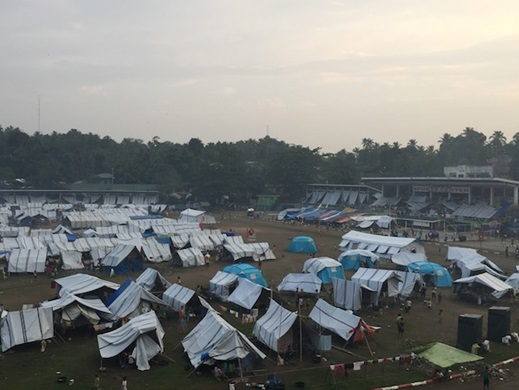
Local authorities and humanitarian partners continue to provide aid
The provincial authorities with support from international and local partners are coordinating relief assistance for the displaced families in the sports complex. Agencies took turns to ensure that all internally displaced people (IDPs) received adequate food assistance since the onset of the crisis.
Tata, however, says they still “lack water and sanitation facilities as there are too many of us.” Daily water supply to the site has dwindled and there are only 10 functional toilets.
To mitigate the situation, health authorities installed 15 waterless portalets and the Philippine Red Cross is constructing 36 additional toilets. Other humanitarian partners provided a communal water bladder and distributed hygiene kits for over 500 displaced families. A hygiene promotion campaign and construction of bathing and other WASH facilities are underway. The authorities also set up a mobile health clinic and local faith groups are conducting medical consultations.
For children whose education was disrupted by displacement, community-run alternative learning programmes resumed two weeks after they fled to the sports complex. Some 100 high school students and 800 elementary school pupils are continuing their classes in temporary learning spaces provided by humanitarian partners. Aid agencies also provided 1,000 elementary school packs, 200 pupil school bags, 50 teacher bags, recreation kits and a library set.
Many are eager to return to their homes but are concerned about the security situation in their villages and thus enduring a protracted stay in the evacuation sites with limited livelihood options. Tata and her fellow lumad people are waiting for lasting peace and adequate protection support in order to resume their normal life in the highlands.Zamboanga IDPs eager to restore livelihoods
About 28,500 displaced people struggle to make their ends meet
She accepts laundry jobs, tends her small vegetable garden in a box and peddles her little produce at a nearby market, yet the income is not enough to feed her family.
Bibing Albani, a 40-year-old mother of six children, lives in Mampang-2, one of the biggest transitional sites in Zamboanga City. Her neighbours are about 4,600 fellow IDPs who were uprooted by the September 2013 conflict between the government forces and a faction of the Moro National Liberation Front. The crisis at its peak displaced some 118,000 people, of whom about 28,500 remain without permanent homes today. Almost 17,200 people stay in 12 transitional sites across the city, while an estimated 11,300 are “home-based” IDPs who are hosted by friends and relatives or renting temporary homes.
Bibing never fails to attend livelihood training offered in Mampang. “I put my heart in all the learning. I used to plant seaweed in the sea. Now I plant tomatoes. I need to learn to survive but it’s not enough.”
Mampang sites are over 10 km away from the city centre. The distance makes life in Mampang expensive. Bibing’s daily earnings of PhP100 ($2.2) cannot cover the transportation cost and support her children.Bibing wishes to return to Barangay Mariki, her home before the conflict, where “PhP20 ($0.44) [a day] was enough to survive.” Mariki is within the central district of Zamboanga, where everything is a walking distance. It is also close to the sea where indigenous Badjiao people like Bibing could catch fish and farm seaweed for livelihood.
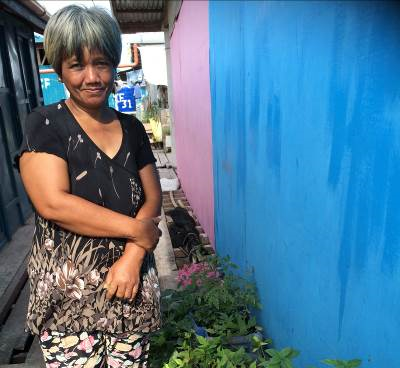
More than a roof
Some displaced mothers have capitalized on relief assistance given to them to rebuild their lives. Rashidam Hussin, a 47-year-old mother of five children, is busy filling her small retail store with food items, medicines, school supplies, clothing, cosmetics and “anything that is needed here.”
When her family was allowed to return to their home ground in Mariki in September 2015,after two years of displacement, Rashidam prioritized putting up her store over housing because “I can always build a house from what I earn from my store.”
Rashidam used a humanitarian cash grant, which she received while staying in the city’s sports complex then used as an evacuation centre, as the base capital for her store. “What is the use of a house when one cannot afford food? Here, we may not have a good roof but we earn. We can eat three times a day. This is what we call a real life,” she says.
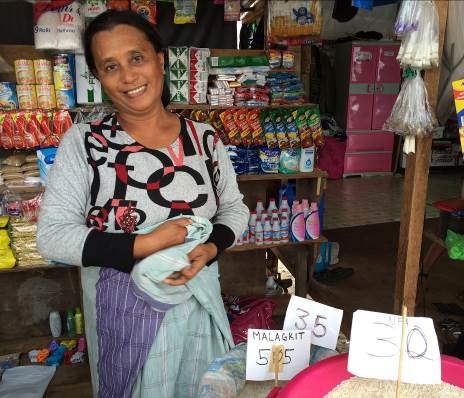
Livelihood assistance by the government and aid agencies
According to Zamboanga City authorities, PhP20 million ($489,000) was allocated as bottom-up budgeting funds to support the livelihood of the displaced. The government also provides free skills development training with scholarships for vulnerable groups including IDPs.
For people like Bibing and Nurmini Hassan, another 28-year-old displaced mother of three children staying in Mampang, these funds fall short of restoring their livelihoods. Nurmini says there is training but not enough capital. “Any cash assistance we receive is barely enough to buy food for survival and my husband resorted to a loan shark.”
In support of the government efforts, FAO and ILO are implementing a joint programme to provide sustainable livelihood opportunities targeting about 400 beneficiaries and their families, in particular the youth, women and indigenous peoples. FAO is distributing fishing gear, fish-processing and seaweed farming kits and vegetable seed packages while ILO is focusing on skills training and community-based enterprise development. The programme aims to provide good examples of livelihood assistance that restore dignity of the long-suffering IDPs and help them rebuild their lives.
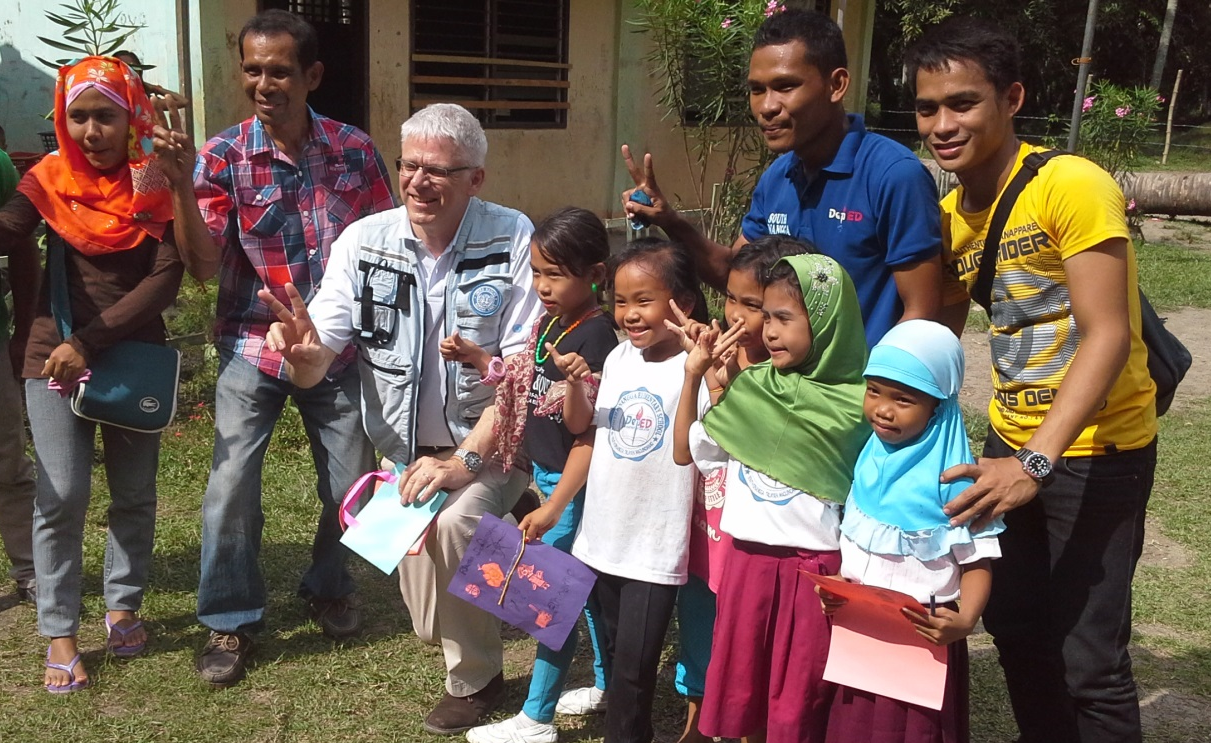
“I used to plant seaweed in the sea. Now I plant tomatoes. I need to learn to survive, but it’s not enough.”
- Bibing Albani, IDP and a mother of six
“Here, we may not have a good roof, but we earn. We can eat three times a day. This is what we call a real life.”
- Rashidam Hussin, IDP and a retail shop owner